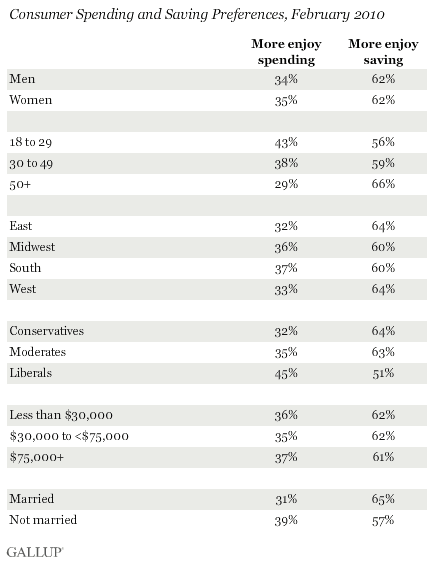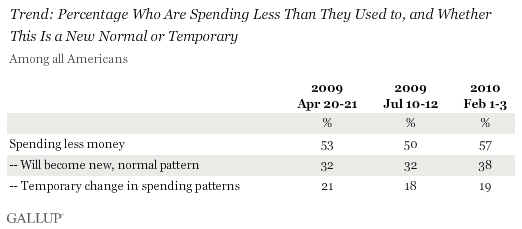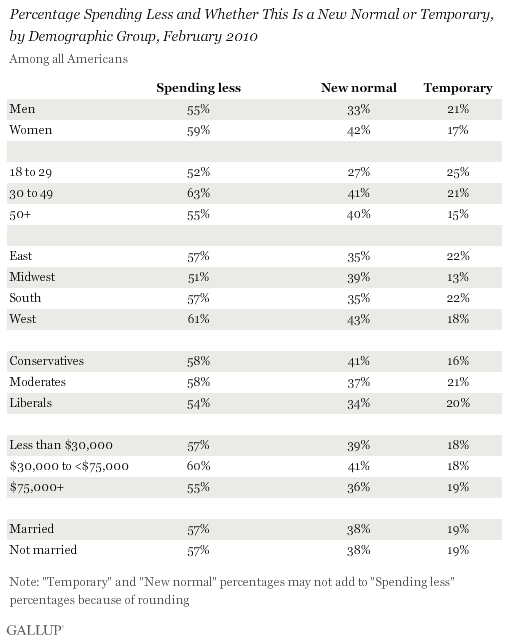PRINCETON, NJ -- The recession and financial crisis have resulted in a significant change in the way many Americans feel about spending and saving. Six in 10 Americans (62%) now say they more enjoy saving than spending -- while 35% say the reverse. This reflects a shift that began in December 2008 and a marked change from the first half of the decade, when Americans were about evenly split regarding whether they more enjoyed spending or saving.

"More than half of the nation's consumers across socioeconomic groups say they are continuing to spend less."
Men and women are about equally likely to say they more enjoy saving rather than spending, and preferences are also essentially the same across income levels and regions. However, those who are not married (39%) are more likely than those who are married (31%) to say they more enjoy spending. Americans aged 18 to 29 (43%) are likewise more likely than those 50 and older (29%) to enjoy spending, as are liberals (45%), compared to moderates (35%) and conservatives (32%).

Spending Less Is the New Normal for Many Americans
Nearly six in 10 Americans (57%) now say they are spending less money in recent months than they used to, up from 50% last July and 53% last April. Thirty-eight percent of all Americans say this reduced spending will be their new, normal spending pattern while 19% say their cutbacks are temporary.

Women are more likely than men to say they are cutting back and that this is a new-normal spending pattern, and middle-aged Americans are more likely than those aged 18 to 29 to say they are spending less.

Changing Consumer Psychology
Essential to the "go forward" economic outlook is whether consumer spending will return to pre-recession levels or reflect a "new normal" spending pattern. The significant shift to saving in American preferences, as opposed to spending, suggests an important change in consumer psychology. Most likely, this change in consumer preferences results from the severity of the recession, the financial crisis, many Americans' severe loss of wealth in their homes and investments, and the significant change in the availability of credit throughout the economy.
At the same time, many consumers also say their spending behavior has changed. More than half of the nation's consumers across socioeconomic groups say they are continuing to spend less, despite the claims of many economic observers that things are getting better and recovery is underway. Two-thirds of consumers who are spending less -- and 38% of all Americans -- say their current reduced level of spending is their new, normal spending pattern. And significant percentages of Americans across all major demographic groups say this is their new normal.
Further, Gallup's continuous tracking of consumer spending behavior in early 2010 shows that consumers are actually doing as they say by -- consistent with their 2009 spending, and much lower than their spending at the beginning of the recession in 2008.
Today's new-normal consumer psychology and spending patterns have broad implications for the U.S. economy. On the positive side, this suggests that many consumers have decided to return to the basics, live within their means, de-leverage, and fortify their personal balance sheets. All of this is good for their personal financial health, and reflects a financial strategy that every American should consider adopting.
While the new normal means the economy will have a financially firmer consumer base to build on going forward, it also suggests American business will need to make some significant adjustments. That is, businesses will have to join their consumer counterparts in adopting a new normal -- not only in terms of spending, borrowing, investing, and fortifying their balance sheets, but also in terms of product design, strategic positioning, and customer/employee engagement, as well as organic and acquisition growth.
In sum, Gallup's consumer data suggest it is time for American businesses to adapt to today's new-normal spending patterns. At the same time, they might hope for a pleasant surprise as Americans who say their current spending cutbacks are "a temporary change" gain confidence and decide it is time to increase their spending again.
about Gallup's economic measures.
Survey Methods
Results are based on telephone interviews with a random sample of 1,025 national adults, aged 18 and older, conducted Feb. 1-3, 2010. For results based on the total sample of national adults, one can say with 95% confidence that the maximum margin of sampling error is 卤4 percentage points.
Interviews are conducted with respondents on land-line telephones (for respondents with a land-line telephone) and cellular phones (for respondents who are cell-phone only).
In addition to sampling error, question wording and practical difficulties in conducting surveys can introduce error or bias into the findings of public opinion polls.
